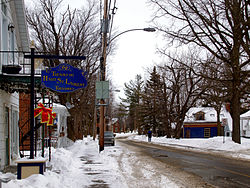Ormstown | |
|---|---|
 | |
 Location within Le Haut-Saint-Laurent RCM | |
| Coordinates: 45°08′N 74°00′W / 45.13°N 74°W[1] | |
| Country | Canada |
| Province | Quebec |
| Region | Montérégie |
| RCM | Le Haut-Saint-Laurent |
| Constituted | January 26, 2000 |
| Government | |
| • Mayor | Christine McAleer |
| • Federal riding | Salaberry—Suroît |
| • Prov. riding | Huntingdon |
| Area | |
• Total | 143.72 km2 (55.49 sq mi) |
| • Land | 142.24 km2 (54.92 sq mi) |
| Population (2021)[4] | |
• Total | 3,917 |
| • Density | 27.5/km2 (71/sq mi) |
| • Pop (2016-21) | |
| • Dwellings | 1,788 |
| Time zone | UTC−5 (EST) |
| • Summer (DST) | UTC−4 (EDT) |
| Postal code(s) | |
| Area code(s) | 450 and 579 |
| Highways | |
| Website | www |
Ormstown is a municipality in Quebec, Canada, which is situated on the Châteauguay River in the heart of the Châteauguay Valley. It is approximately one hour southwest of Montreal and 20 minutes north of New York State in the United States. The population as of the 2021 Canadian census was 3,917.
Ormstown has two elementary schools, one high school (Chateauguay Valley Regional), and two adult education facilities, several restaurants and churches. Ormstown is also well known for its numerous antique dealers and unique gift shops. There is a park north of the centre of town which is home to Ormstown Beach, an urban legend created and memorialized in the 1970s with "I've been to Ormstown Beach" bumper stickers. It is a popular summer activity to cycle along the Châteauguay River. The town has traces of an old dam, which was once the source of power for the mill. People living outside the town only gained access to electricity following World War II.
- ^ Cite error: The named reference
toponymiewas invoked but never defined (see the help page). - ^ a b "Répertoire des municipalités: Geographic code 69037". www.mamh.gouv.qc.ca (in French). Ministère des Affaires municipales et de l'Habitation.
- ^ Riding history for Beauharnois—Salaberry, Quebec from the Library of Parliament
- ^ a b "Ormstown (Code 2469037) Census Profile". 2021 census. Government of Canada - Statistics Canada.
